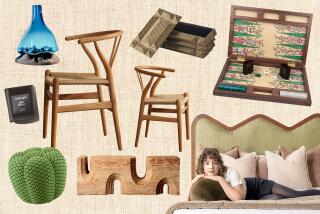Through furniture, he saw the future
- Share via
LONG before there was furniture by Ralph Lauren, Calvin Klein, Isaac Mizrahi and a gaggle of other hotshot fashion designers, there were home furnishings by the French couturier, Pierre Cardin.
In fact, Cardin, 84, was the guy who pretty much started the big shift from designing clothes to designing chairs, tables and credenzas back in 1970.
That’s when he ventured beyond his iconic sculptural, lunar-look dresses (it was the Space Age, after all) and his high-end disco-doll outfits (vinyl thigh-high boots and minis) and began to put his abstract “PC” logo on anything a person might need from morning to night, throughout the entire house -- clothes, cufflinks, coffee makers, pens, wallets, bathroom fixtures, furniture, bikes, cars and planes.
Cardin, who started his fashion career in 1946 at Christian Dior, ascended to master of the universe status in the 1960s when he became a household name with his uninhibited, swingy styles that perfectly mirrored the unleashed attitude of the era.
In 1959, he broke new ground with the world’s first ready-to-wear by a major Paris designer. This did not thrill his colleagues, who accused him of cheapening the image of high fashion -- and the astronomical prices that went with it. Of course, most eventually followed suit.
In 1969, Cardin made the cover of Time magazine, bare chested, his gaunt, chiseled features peering out alongside a piece of his new Cardin furniture -- a white, molded plastic chair with an inner cocoon of pouffy black leather. Like much of the furniture he was to make through the ‘70s and ‘80s, it seemed straight out of a James Bond film -- a bit futuristic, eye-popping and fun.
Cardin was as much an entrepreneur as he was a designer. Although he probably designed couture clothes with his own hand, he didn’t necessarily do that with anything else that bore his signature, including his furniture. Instead, he hired collaborators -- young talents who could think out of the box and come up with ideas that represented his vision. Philippe Starck was among those who cut his design teeth in Cardin’s think tank.
Throughout the ‘70s and early ‘80s, Cardin’s initials went on limited editions of furniture made of rubber, veneered wood, plastic and metal -- on tables, credenzas, chairs, desks, beds, lamps, rugs. Then he went on to make less expensive versions of these for the mass market. He believed that designing furniture and clothes shared the same dimension. “Furniture must live through the body,” Cardin said in 1968. Just as clothing must.
A new coffee table book, “Pierre Cardin Evolution: Furniture and Design” by Benjamin Loyaute, is filled with close-ups of Cardin furniture, and spotlights the designer’s 1970s vision for the modern home. That furniture still has currency among some collectors on both coasts.
Courtney Newman, who owns Modern Way vintage furniture in Palm Springs, says Cardin is selling fairly well now. “A few years ago, you couldn’t give it away. Now it’s pretty popular with people into furniture by fashion designers.” In current stock, Newman says, is “a bedroom set of white laminate with chrome strips that’s very kind of glamour-’70s. It’s $5,000. I recently sold a huge Cardin bedroom set -- three dressers, two highboys, two nightstands, a bed and credenza for about $10,000. An architect bought it and made it into kitchen cabinets.”
Carla Nora of Carla in Hollywood says she used to sell more Cardin than she does now. “It’s really hard to find pieces in good condition.”
Peter Loughrey, owner of Los Angeles Modern Auctions, finds a narrow but strong niche market for vintage Cardin pieces, especially among those who value it as a symbol of the ‘70s.
“It’s difficult for any designer to come up with something really of the moment, to create furniture that is, in essence, a window into that moment. Cardin’s furniture does that,” Loughrey says. “I see it and I imagine someone going out to Studio 54, wearing a shiny Paco Rabanne minidress, then going back to Andy Warhol’s Factory and hanging out with Peggy Moffitt.”


